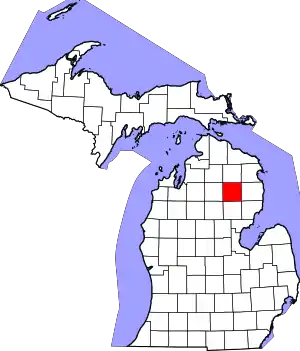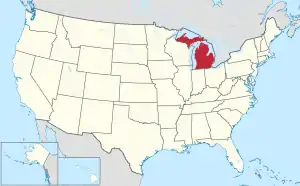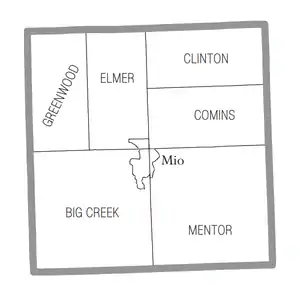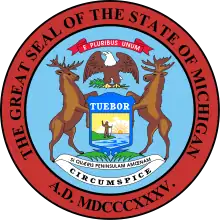Oscoda County, Michigan
Oscoda County is a county in the U.S. state of Michigan. As of the 2010 census, the population was 8,640,[2] making it the fifth-least populous county in Michigan, and the least populous county in the Lower Peninsula. The county seat is Mio,[3] an unincorporated community near the center of the county.
Oscoda County | |
|---|---|
.jpg.webp) Oscoda County Courthouse in Mio | |
 Location within the U.S. state of Michigan | |
 Michigan's location within the U.S. | |
| Coordinates: 44°41′N 84°08′W | |
| Country | |
| State | |
| Founded | April 1, 1840 (created) 1881 (organized)[1] |
| Seat | Mio |
| Largest community | Mio |
| Area | |
| • Total | 572 sq mi (1,480 km2) |
| • Land | 566 sq mi (1,470 km2) |
| • Water | 5.9 sq mi (15 km2) 1.0%% |
| Population | |
| • Estimate (2018) | 8,276 |
| • Density | 15/sq mi (6/km2) |
| Time zone | UTC−5 (Eastern) |
| • Summer (DST) | UTC−4 (EDT) |
| Congressional district | 1st |
History
The county was established on April 1, 1840 by act of the Michigan State legislature. However, its governing structure was not completed until 1881.[1] The name is a Henry Rowe Schoolcraft neologism, thought to be a combination of two Ojibwa words, "ossin" (stone) and "muskoda" (prairie) -- hence 'pebbly prairie.'[4] He served as the US Indian agent and was also a geographer, surveying and naming newly established counties and towns.
Geography
According to the U.S. Census Bureau, the county has an area of 572 square miles (1,480 km2), of which 566 square miles (1,470 km2) is land and 5.9 square miles (15 km2) (1.0%) is water.[5] Oscoda County is part of Northern Michigan.
Geographic features
- Mio is situated in the Au Sable River Valley.
- The County is surrounded by the Huron National Forest and the Rifle River State Recreation Area.
- The County is part of the Au Sable State Forest, specifically the Grayling Fire Management Unit, which consists of Alcona, Crawford, Oscoda, and northern Iosco counties.
- Much of the area sits on the "Grayling outwash plain", a unique habitat.[6]
- The Oscoda County Park offers a good vantage point.[7]
Glaciers shaped the area, creating a unique regional ecosystem. Much of the area is the Grayling outwash plain, a broad outwash plain including sandy ice-disintegration ridges, jack pine barrens, white pine-red pine forest, and northern hardwood forest. Large lakes were created by glacial action.[6]
Major highways
 M-33 – runs north–south through the central part of the county. Passes Fairview and Mio.
M-33 – runs north–south through the central part of the county. Passes Fairview and Mio. M-72 – enters west end of county near its central part. Runs east to intersection with M-33 at Mio. Passes Luzerne. It is one of three true cross peninsular highways.[8]
M-72 – enters west end of county near its central part. Runs east to intersection with M-33 at Mio. Passes Luzerne. It is one of three true cross peninsular highways.[8] F-32 – runs east from Mio into Alcona County. Passes McKinley.[9]
F-32 – runs east from Mio into Alcona County. Passes McKinley.[9]
Adjacent counties
- Montmorency County - north
- Alpena County - northeast
- Alcona County - east
- Iosco County - southeast
- Ogemaw County - south
- Roscommon County - southwest
- Crawford County - west
- Otsego County - northwest
National protected area
- Huron National Forest (part)
Demographics
| Historical population | |||
|---|---|---|---|
| Census | Pop. | %± | |
| 1870 | 70 | — | |
| 1880 | 467 | 567.1% | |
| 1890 | 1,904 | 307.7% | |
| 1900 | 1,468 | −22.9% | |
| 1910 | 2,027 | 38.1% | |
| 1920 | 1,783 | −12.0% | |
| 1930 | 1,728 | −3.1% | |
| 1940 | 2,543 | 47.2% | |
| 1950 | 3,134 | 23.2% | |
| 1960 | 3,447 | 10.0% | |
| 1970 | 4,726 | 37.1% | |
| 1980 | 6,858 | 45.1% | |
| 1990 | 7,842 | 14.3% | |
| 2000 | 9,418 | 20.1% | |
| 2010 | 8,640 | −8.3% | |
| 2018 (est.) | 8,276 | [10] | −4.2% |
| US Decennial Census[11] 1790-1960[12] 1900-1990[13] 1990-2000[14] 2010-2018[2] | |||
As of the 2000 United States Census, 9,418 people, 3,921 households, and 2,717 families resided in the county. The population density was 17 people per square mile (6/km2). There were 8,690 housing units at an average density of 15 per square mile (6/km2). The county's racial makeup was 97.82% White, 0.08% Black or African American, 0.71% Native American, 0.07% Asian, 0.01% Pacific Islander, 0.14% from other races, and 1.16% from two or more races. 0.94% of the population were Hispanic or Latino of any race. 30.2% were of German, 12.8% American, 9.6% English, 8.1% Polish, 6.8% French and 6.7% Irish ancestry. 94.1% spoke English, 2.8% German and 1.5% Pennsylvania Dutch as their first language.
There were 3,921 households, out of which 25.30% had children under the age of 18 living with them, 58.10% were married couples living together, 7.50% had a female householder with no husband present, and 30.70% were non-families. 26.00% of all households were made up of individuals, and 12.70% had someone living alone who was 65 years of age or older. The average household size was 2.39 and the average family size was 2.85.
The county population contained 23.30% under the age of 18, 5.60% from 18 to 24, 22.80% from 25 to 44, 28.00% from 45 to 64, and 20.20% who were 65 years of age or older. The median age was 44 years. For every 100 females there were 96.40 males. For every 100 females age 18 and over, there were 95.30 males.
The median income for a household in the county was $28,228, and the median income for a family was $32,225. Males had a median income of $30,013 versus $20,202 for females. The per capita income for the county was $15,697. About 10.30% of families and 14.60% of the population were below the poverty line, including 20.40% of those under age 18 and 8.80% of those age 65 or over.
Government
Oscoda County has been reliably Republican since its organization. Since 1884, the Republican Party nominee has carried the county vote in 85% (29 of 34) of the national elections through 2016.
| Year | Republican | Democratic | Third Parties |
|---|---|---|---|
| 2020 | 71.0% 3,466 | 27.5% 1,342 | 1.5% 72 |
| 2016 | 69.5% 2,843 | 25.5% 1,044 | 5.0% 205 |
| 2012 | 57.0% 2,308 | 40.9% 1,657 | 2.2% 88 |
| 2008 | 53.4% 2,320 | 43.4% 1,887 | 3.2% 139 |
| 2004 | 58.3% 2,570 | 40.6% 1,792 | 1.1% 47 |
| 2000 | 55.3% 2,207 | 42.0% 1,677 | 2.7% 108 |
| 1996 | 41.5% 1,545 | 44.4% 1,652 | 14.2% 528 |
| 1992 | 41.3% 1,583 | 38.4% 1,471 | 20.3% 777 |
| 1988 | 62.3% 1,972 | 36.9% 1,170 | 0.8% 25 |
| 1984 | 69.8% 2,239 | 29.6% 951 | 0.6% 19 |
| 1980 | 55.3% 1,915 | 38.2% 1,325 | 6.5% 226 |
| 1976 | 57.6% 1,541 | 41.4% 1,108 | 1.1% 28 |
| 1972 | 67.6% 1,561 | 29.4% 678 | 3.0% 70 |
| 1968 | 61.0% 1,124 | 30.5% 563 | 8.5% 157 |
| 1964 | 45.6% 784 | 54.0% 930 | 0.4% 7 |
| 1960 | 71.9% 1,174 | 28.0% 458 | 0.1% 2 |
| 1956 | 78.0% 1,044 | 22.0% 294 | 0.0% 0 |
| 1952 | 80.7% 1,047 | 19.0% 246 | 0.3% 4 |
| 1948 | 72.1% 785 | 26.2% 285 | 1.7% 19 |
| 1944 | 64.7% 615 | 35.0% 332 | 0.3% 3 |
| 1940 | 61.6% 661 | 38.1% 409 | 0.3% 3 |
| 1936 | 47.7% 456 | 51.5% 492 | 0.8% 8 |
| 1932 | 52.9% 410 | 45.0% 349 | 2.1% 16 |
| 1928 | 86.4% 476 | 13.3% 73 | 0.4% 2 |
| 1924 | 82.2% 389 | 11.0% 52 | 6.8% 32 |
| 1920 | 83.8% 439 | 14.3% 75 | 1.9% 10 |
| 1916 | 57.0% 245 | 40.7% 175 | 2.3% 10 |
| 1912 | 32.5% 110 | 19.5% 66 | 48.1% 163 |
| 1908 | 72.8% 331 | 24.6% 112 | 2.6% 12 |
| 1904 | 86.1% 323 | 11.7% 44 | 2.1% 8 |
| 1900 | 79.8% 245 | 19.5% 60 | 0.7% 2 |
| 1896 | 80.8% 308 | 16.5% 63 | 2.6% 10 |
| 1892 | 59.1% 273 | 39.0% 180 | 2.0% 9 |
| 1888 | 47.2% 277 | 50.9% 299 | 1.9% 11 |
| 1884 | 68.6% 199 | 30.0% 87 | 1.4% 4 |
Oscoda County operates the County jail, maintains rural roads, operates the major local courts, records deeds, mortgages, and vital records, administers public health regulations, and participates with the state in the provision of social services. The county board of commissioners controls the budget and has limited authority to make laws or ordinances. In Michigan, most local government functions – police and fire, building and zoning, tax assessment, street maintenance etc. – are the responsibility of individual cities and townships.
Elected officials
- Prosecuting Attorney – Kristi Mcgregor
- Sheriff – Kevin R. Grace
- County Clerk/Register of Deeds – Jeri Winton
- County Treasurer – William Kendall
- Commissioner Dist. 1 – Chuck Varner
- Commissioner Dist. 2 – Tom McCauley
- Commissioner Dist. 3 – Jackie Bondar
- Commissioner Dist. 4 – Kyle Yoder
- Commissioner Dist. 5 – Libby Marsh
current as of January 2019
Recreation
The Michigan AuSable Valley Railroad in Fairview, is 1/4 scale 16 gauge railroad that offers rides on a passenger train through 1.5 miles (2.4 km) of jack pine country during the summer months. Riders travel through parts of the Huron National Forest overlooking the Comins Creek valley.[16]
The AuSable River, near Mio, provides opportunity for fishing and canoeing/kayaking/tubing. The M-33 access north of Mio has a launch area and public facilities. A second launch area is at the Mio Dam Pond.
Oscoda County offers snowmobile trails, ATV trails, hiking trails, and cross country skiing trails. Snowmobile and ATV trails are located throughout Luzerne, McKinley, and Mio. There is a scramble area at Bull Gap in the Huron National Forest. The Loud Creek Trail offers 7 different routes with varying difficulty levels. The trail's total distance is 10 kilometers.
In Fairview, there is a horseback riding ranch and a golf course. Karefree Ranch Boarding Stables offers guided horseback rides in Huron National Forest. The Fairview Hills Golf Club is a 9-hole golf course on M-33.[17]
The annual OC Riverfest, designed to celebrate Oscoda County's most prize asset, the AuSable River, is an annual weekend event.
Communities

Civil townships
Census-designated place
- Mio (county seat)
See also
References
- "Bibliography on Oscoda County". Clarke Historical Library, Central Michigan University. Retrieved January 29, 2013.
- "State & County QuickFacts". US Census Bureau. Archived from the original on July 16, 2011. Retrieved August 29, 2013.
- "Find a County". National Association of Counties. Retrieved June 7, 2011.
- Michigan History, Arts and Libraries on sources of County names.
- "2010 Census Gazetteer Files". US Census Bureau. August 22, 2012. Retrieved September 27, 2014.
- "NPWRC :: Regional Landscape". usgs.gov.
- Oscoda County Park (accessed 17 October 2007)
- History of Michigan highways.
- Oscoda County MI Google Maps (accessed 17 September 2018)
- "Population and Housing Unit Estimates". Retrieved May 16, 2019.
- "US Decennial Census". US Census Bureau. Retrieved September 27, 2014.
- "Historical Census Browser". University of Virginia Library. Retrieved September 27, 2014.
- "Population of Counties by Decennial Census: 1900 to 1990". US Census Bureau. Retrieved September 27, 2014.
- "Census 2000 PHC-T-4. Ranking Tables for Counties: 1990 and 2000" (PDF). US Census Bureau. Retrieved September 27, 2014.
- US Election Atlas
- "Home".
- Eye on Michigan Mio
External links
| Wikimedia Commons has media related to Oscoda County, Michigan. |
- Oscoda County Web Site
- Au Sable Valley connection
- Enchanted forest, Northern Michigan source for information and calendars
- Calendar of Events, Sunrise side
- Sunrise side travel and information
